Salad bars aren’t for everyone. They’re insanely convenient, but the pricing can be tricky and you really have to be careful about which salad bars are clean, safe, and properly tended. I’m not going to talk about why you should or shouldn’t use a salad bar (as a microbiologist with pretty extensive food safety training, I know the dangers they can pose) because we’re all adults and I think you can make that call yourself. But I do want to talk about how to navigate that salad bar, if you so choose, so that you don’t get “taken to the bank.”
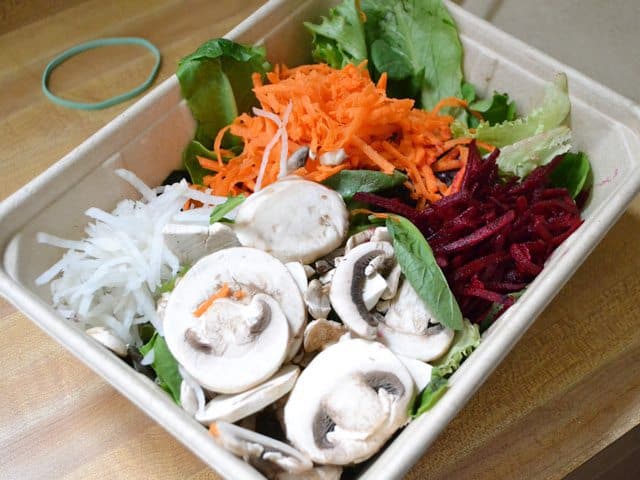
I use salad bars on occasion when I want just a handful of a certain vegetable and don’t want to buy a whole bunch, bag, or container. I also use the salad bar when I’m craving a super vegilicious salad with ten different flavors and textures, but don’t feel confident that I will use up the rest of those ten vegetables if I were to buy each one. It’s still a splurge to build a salad at the salad bar, but less of a splurge than buying a pre-made salad from a deli or cafe.
How Salad Bars Work
Salad bars are priced by the pound, which can make it really hard to judge how much you’re spending. Piling whatever looks good into your box will quickly lead to a two pound plus salad that will easily cost you over $15. A pound never weighs as much as you think it does! Each item on the salad bar has a different value, but with the per-pound pricing you’re paying a flat rate for all of them. The store hopes that you’ll pile on the lower priced items and the profit earned from those will balance out their losses on more expensive items. Luckily, you get to choose which items you want.
Salad Bar Rules
1. Bulk up on light weight items and avoid the heavy ones.
It’s simple: the more your salad weighs, the more you pay. What weighs a lot? Anything that has a lot of water, like tomatoes, cucumbers, SALAD DRESSING, pasta, hard boiled eggs, chicken or tuna salads, cooked beans and grains, and fresh fruit. What doesn’t weigh a lot? Things that have a low density or have a low moisture content: leafy greens, mushrooms, croutons, seeds, nuts, and dried fruit. Of course, these are not all inclusive lists, just things I’ve thought of off of the top of my head. Evaluate your salad bar items on a per item basis. A lot of items will fall somewhere in the middle when it comes to weight and these can be used sparingly (I’m not opposed to adding a few beans like edamame or chickpeas, just go lightly).
2. Size and shape matter.
The size and shape of the item also makes a big difference. I frown on large chunks because they are heavy and don’t go far in my salad (not to mention, just difficult to eat). Instead of slicing, my local Whole Foods shreds a lot of their vegetables for the salad bar, which means I only need a little scoop to spread the flavor throughout the entire salad. I LOVE that. In general, go for items that are sliced thin or cut small because that helps a little bit go a long way.
3. Compare salad bar prices to regular item prices.
One way to take advantage of per pound pricing on salad bars is to load up on things that would cost more if you bought them off the shelf. A lot of nuts, seeds, and specialty cheeses fall into this category. Walnuts and pecans are often around $10/lb. when purchased in other parts of the store, but the salad bar price may be less, so you win.
Likewise, avoid things that are insanely cheap normally, because you’re getting charged $7+ per pound for them on the salad bar. Case in point: beans and pasta. Super cheap to just go buy, super expensive on the salad bar.
4. Use your own dressing.
If you’ll be eating the salad at home, by all means do NOT add dressing at the salad bar. That will add weight more quickly than anything other item. If that’s not an option, see if the salad bar has dressing packets or small cups for the dressing to that won’t be weighed with the salad (check the store policy, some stores weigh dressings even if it’s in a separate cup). And if you absolutely must add dressing, just be mindful and go sparingly.
5. Replicate pre-packaged salads.
In addition to the salad bar, supermarkets often have pre-packaged salad bowls ready to just grab and go on the refrigerated shelves right next to the salad bar. These salads are made from the exact same ingredients in the exact same room as the salad bar items, they’re just pre-assembled. I can’t tell you how many times I’ve built the exact same salad from the salad bar for half the price of what was in the pre-packaged container. It’s crazy. Crazy good.
Here’s my loot…
You can see the “whole” salad at the top of the post. I pretty much filled the container with a LOT of spring mix first, then added a scoop each of shredded carrot, daikon, beets, mushrooms, and some cloves of roasted garlic. When I got home, I divided it up into three decent sized side salads to eat with my lunch over the next few days (they’re bigger than they look – the ingredients are packed). Make sure not to buy more than what you can eat before it gets wilty, otherwise it’s just an all-around waste.
The whole salad cost $5.18 and I was able to get three pretty decent sized side salads out of it for $1.73 each. Much better quality and price than if I had bought those salads from the cafeteria at work. As I was leaving the salad bar area, I saw some pre-packaged salads that were slightly smaller than what I got (maybe equal to two of my smaller, divided salads) and they were $7.99, so I think I came out on top here.
I may even add my own hard boiled eggs (WAY cheaper than adding from the salad bar) and any nuts or seeds that I have in my pantry. At least I didn’t have to buy all those carrots, beets, mushrooms, and daikon. Have you seen daikon? They’re HUGE. What would I do with the rest of it?
In Conclusion…
I still consider buying salads like this to be a splurge, but it can be a sensible splurge if executed correctly. Proceed with caution (and knowledge!).


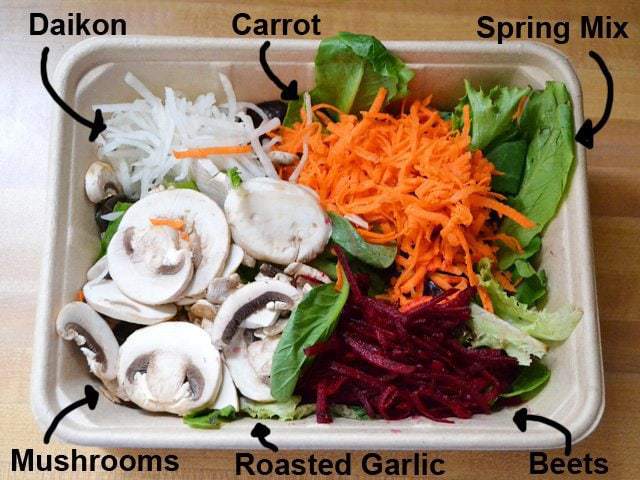
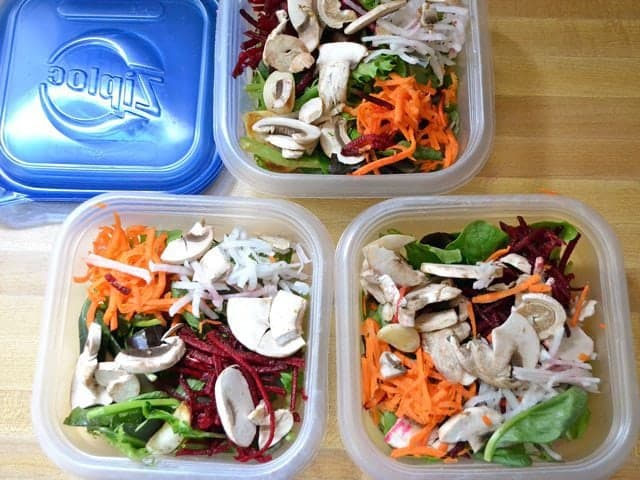
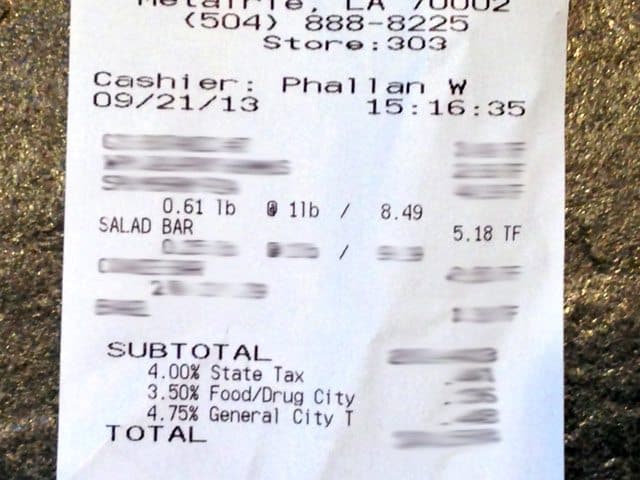
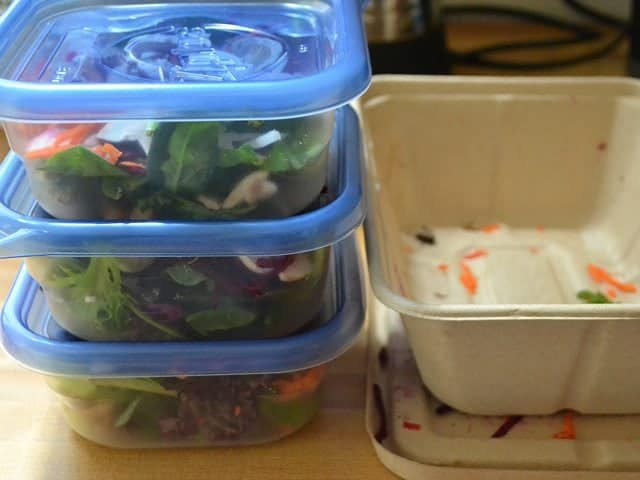
There are two number 2s
I consider $5.99 to be too high of a salad bar price – let alone your Whole Foods $8.49 price.
If you are this concerned about pinching pennies – Whole Foods is probably not the place you should be shopping.
Just Sayin’
Whole Foods has better prices on many basic items than my regular grocery store. I don’t buy everything there, but there are a few items that I save a lot on. It’s going to be different for everyone, so the key here is to shop around and not assume.
Putting my two cents in. I wanted to make a greek salad tonight and was floored that a jar of kalamata olives cost $6 and that a 6 oz container of feta cheese cost $5 in my area. I don’t eat a greek salad every day so it would be likely that leftover olives and cheese will go bad over time. I had all of the other ingredients and was making a home-made dressing… so what did I do? I got some side item containers at the stores salad bar, got enough olives and cheese to make my Salad for two people and paid a total of $1.57 at the rate of $7.99 per pound.
wow…i had never considered using the salad bar for more than just a take away salad to eat. so i tried this tip today. i did a cold mayo based type salad yesterday and had some leftover, but wanted to dress it up with something new. so while at the store, remembering this post, i stopped by the bar and picked up just a tiny handul of a couple of things i thought would go well in it. paid less than $2 for small amounts of 4 different items. used some today. will use more tomorrow. and none of it will go to waste, unlike whole versions of any one item if purchased individually that i’m sure would get trashed before being used up. so resourceful!
Good stuff to know!
Here’s another post I found helpful.
http://www.huffingtonpost.com/2014/09/19/whole-foods-salad-bar-win-it-you-can_n_5844160.html
Thank you this was also helpful!
I like to use the salad bar to make omelette fixings for the kids and I when I’m already at the store and know I’ll need to make something quick when I get home. I like the more exotic stuff and my kids tend more towards ham and cheese. This way we all get what we like best. I only need a tiny amount of each ingredient so I’m able to feed all of us for just a couple of dollars.
Great post! And the light weight ingredients you loaded up on are also less fattening and healthier than some ofthe heavier items. Win win!
This article was so helpful! I constantly buy lunch from salad bars because they are so convenient, and I usually spend at least $6! I usually stop at one when I’m craving something odd, like beets or mushrooms, and I just want to buy enough for one meal. Getting items that are small, like nuts and shredded carrot, was a really great idea! That’s the perfect way to get a little bit with each bite! Thanks so much for the helpful info!
My usual salad bar combo is spring greens, a few edamame, blue cheese crumbles, dried cranberries if they are there, and some nuts, depending on what they are–since I’m eating out at the time I do add just a sprinkle of dressing. I don’t think anything at all in that batch is going to cost me less than about $6 a lb if I’m buying off the shelves, and my salads rarely cost me more than about $3. I’ve been constructing them in this cost effective way for years. And the salad bar ($6.99 at my supermarket) is cheaper than the olive bar which sells antipasto items and olives for $8.99–many of the same things in both places.
You should never eat raw button mushrooms. They contain a carcinogenic toxin that breaks down with heat. Not many people know this, so they are often stocked in salad bars. Here is some information on this topic: http://www.mykoweb.com/articles/EatingRawMushrooms.html
Given that the article also says this, you probably shouldn’t worry about it too much:
We need to keep in mind that lab tests and subsequent conclusions drawn concerning carcinogenic or mutagenic health hazards of hydrazine involve massive doses of isolated extracts administered to mice in a concentrated time frame. Similarly disturbing test results are likely to be found with many substances present in many, many foods humans commonly eat without suffering or even worrying about any particular health concern. The relatively unblemished human history of consuming edible Agaricus species suggests we may continue to do so. The science may suggest we should not over indulge, but we already knew that.
I would be interested in reading that too. I know the potential for cross contamination is very high.
“Have you seen daikon? They’re HUGE. What would I do with the rest of it?”
Anything you can do with turnips or salad radishes, you can do with daikon. Make some quick Japanese refrigerator pickles, steam it and eat it with a splash of soy sauce, make a pot of oden, add it to stir fry vegetables, chunk it up and throw some into beef or chicken stew, etc.
(Oden is a traditional Japanese winter vegetable soup featuring your choice of daikon, potatoes, sweet potatoes, carrots, Napa or regular cabbage, mushrooms, seaweed, konnyaku, broth, and various forms of protein, including tofu, aburage, hard boiled eggs, meat, poultry, or fish. It’s eaten with hot Japanese mustard, and will keep out even the chill of a Hokkaido winter. There are thousands of recipes; every family has their own!)
Those are great ideas! I like daikon Kimchi too. Our local Korean place makes it so I googled a recipe & found its pretty common. Sweeter than traditional kimchi.
What you can do with lots of daikon:
Rice (cooked and cold)
Tomatos, Daikon, Onion and Scallions
Slice all the greens, mix everything together and add
Sesame-oil
rice vinegar
soysauce
Mix again and then enjoy.
Great for taking to work as lunch, tasty and filling.
Daikon is really good in a stir fry and also wonderful in homemade egg rolls! It gives both of these dishes a nice crunch. I usually purchase asian themed veggies and have asian dishes multiple times a week in order to use them all up. Daikon, scallions, and nappa cabbage in particular. (These always seem to be huge at my local grocery stores)
Any chance you can do a quick and dirty run down on how to avoid badly tended salad bars? As a non microbiologist with only basic food safety knowledge, I will probably end up getting extremely ill.
Make sure it’s clean, tidy, and well stocked – that’s a good indicator that someone is actually taking care of it. The biggest danger is temperature. The ingredients need to stay cool (below 40F) to be in the safety zone. It’s hard to tell by looking, but if they look dry, dull, and limp, it’s a good indicator that things aren’t properly chilled. Also, if the bins are over filled, they’re going to be above the line of refrigeration. Salad bars are always a gamble, so you just have to make sure the one you pick is well managed :)
Yeah! Been doing this at Whole Foods for years. I even skip the lettuce, buy my own and chop it up, makes plenty of individual salads with all the exotic veggies. Make your own dressing of course.
I even used to buy a box of bacon there each morning until they got wise to how much $ they were losing from my 43¢ box packed full of delicious thick sliced free range bacon.
Whenever my husband and I hit the salad bar, his will be closer to $10, while mine will be in the $2-$3 range.
This is how I roll too! whoohoo!
Huh, I’d never thought about doing something like this! Our grocery store doesn’t have a salad bar, but we do have an olive bar. Got any advice on that? :) It’s like $8 a pound too.
I use the olive bar on occasion if I just want a handful of olives. That way I can avoid buying a whole $6 dollar jar. But that’s about it :)
Love this post! I purchase salads at Whole Foods a lot and I have been a victim of the $15 salad. It only took once for me to wise up to the madness though. I’ve started going to the salad bar at my local store and purchasing part of a complete salad, then finishing it up with ingredients I already have at home. It’s a perfect solution for someone who travels a lot for work like I do.